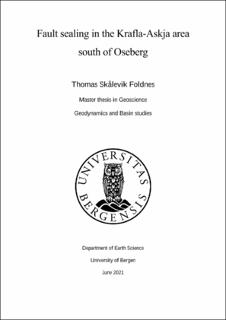| dc.description.abstract | Fault sealing is one of the key factors that control hydrocarbon accumulations. Faults in the subsurface can act as a conduit or a barrier to fluid flow and pressure communication. Understanding fault behavior is essential for hydrocarbon exploration, drilling, and development. There have been multiple studies with well-established workflows for carrying out a fault seal analysis based on clay content. The world is and will be dependent on oil and gas in years to come. With the rapidly growing climate problem, knowledge about fault sealing is crucial for carbon capture and storage (CCS). Fault plane maps, together with a horizon map and pressure data, are helpful when working on fault sealing, giving a three-dimensional view of fluid migration and trapping. The Krafla-Askja area consists of relatively new discoveries, with the first well drilled at Krafla in 2011 and Askja in 2013. Cross-fault spill points generally define the limit for hydrocarbon column heights. However, hydrocarbon columns which reach deeper than the spill points are common in the Krafla-Askja area. This study aimed to investigate the geological constraints of fluids within the sands in the Brent Group in the Krafla-Askja area in the northern North Sea. A regional seismic interpretation of the Viking and Brent Groups was created based on 3D seismic data and published data from exploration wells. Detailed interpretation of 13 faults was conducted to map sand-sand juxtapositions along the faults, with a total of 77 juxtapositions being observed between Tarbert and Ness sands. Shale gouge ratio and across fault pressure differences in the juxtaposed areas were used with the intent to understand why these sets of structures behave in the way they do. The Krafla-Askja area is heavily faulted with the structures being compartmentalized, varying in lateral communication. Migration routes are suggested to be closed with 13 faults working as fluid barriers. One fault north of Slemmestad, however, might be partially open in the water phase. Clay smear and seal by juxtaposition are suggested to be the main reason for sealing in the Krafla-Askja area. Five structures containing hydrocarbon are situated shallower than the oil and gas windows for the Draupne and Heather Formations suggesting that hydrocarbon migration has previously occurred in the area. WNW-ESE and E-W oriented faults perpendicular to the Viking Graben are critically stressed in the present-day stress field and are thought to be reactivated more recently, resulting in a lower across fault pressure difference. | |
